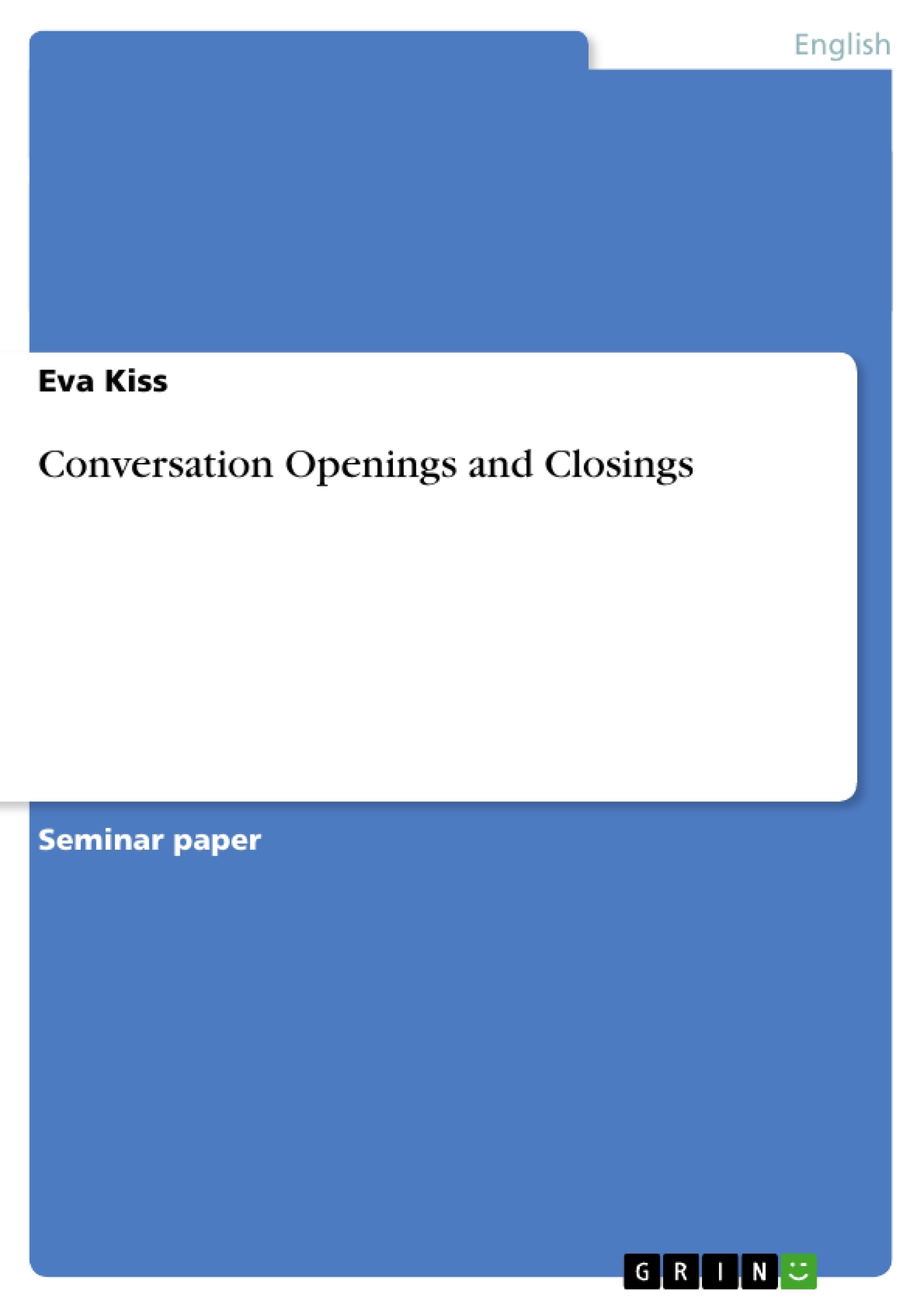Every conversation is different from all others. Nobody ever had exactly the same private conversation
again, even if he conversed about the same topic. Nevertheless there are certain
items in conversations that are very alike or completely alike, and which seem to be build on
certain schemes. Places in conversations where these schemes occur are openings and closings.
The aim of this paper is to examine the mechanisms behind this phenomenon and to examine if
and how these mechanisms have changed since they were first examined by Schegloff and
other linguists in the 1970’s. For providing the necessary background information, I will first
give some basic features of conversation analysis which are important for the topic, before
moving on to conversation openings and finally to conversation closings.
In openings I will especially focus on the summons-answer structure, identification and recognition
as well as on the changes that had to be made and were made to the structure since
the establishment of number identification. Closings will be examined by their components and
the different possibilities they provide will be analysed.
As stated by Levinson (1983: 309) telephone conversation is one of “social activities effectively
constituted by talk itself“. This is, that the conversation is not disturbed in its pureness by
extra-linguistic features like “physical doings and positionings” (Schegloff 1973: 323). Participating
hearers have to interpret the utterances with nothing more than voice, words, intonation
and pauses which can be analysed linguistically. Also the beginnings and endings – and because
of that also the opening and closing places - of such conversation can clearly be determined,
as telephone conversation usually has a duration of the time of the call. Therefore telephone
conversation is most suitable for linguistic research and I will focus on such conversation
only (Schegloff 1973: 325).
Inhaltsverzeichnis (Table of Contents)
- A) INTRODUCTION.
- B) CONVERSATION OPENINGS AND CLOSINGS.
- 1. CONVERSATION ANALYSIS..
- 1.1 Basics..
- 1.2 Adjacency Pairs.
- 1.3 Preference Organisation.
- 2. OPENINGS
- 2.1 Summons-Answer..
- 2.2 Identification and Recognition.
- 2.3 Mobile Telephones and Number Identification.....
- 3. CLOSINGS
- 3.1 Closing Section and Terminal Exchange..
- 3.2 Closing Components and Pre-Closings...
- C) CONCLUSION.
Zielsetzung und Themenschwerpunkte (Objectives and Key Themes)
This paper explores the mechanisms behind conversation openings and closings, examining how these structures have evolved since their initial analysis by Schegloff and other linguists in the 1970s. The focus is on telephone conversations as a prime example of a social activity constituted solely by talk, enabling clear analysis of openings and closings.
- Conversation analysis and its application to opening and closing sequences.
- The evolution of opening structures, particularly the shift from summons-answer to identification and recognition.
- The role of adjacency pairs in structuring conversations, including preferred and dispreferred responses.
- The analysis of closing components and pre-closings in telephone conversations.
- The impact of technological advancements, such as mobile phone number identification, on conversation openings.
Zusammenfassung der Kapitel (Chapter Summaries)
- A) Introduction: This chapter introduces the topic of conversation openings and closings, highlighting their significance in shaping social interaction. It emphasizes the study's focus on telephone conversations and outlines the theoretical framework of conversation analysis.
- 1. Conversation Analysis: This chapter delves into the fundamentals of conversation analysis, focusing on its core concepts such as adjacency pairs and preference organization. It explains how these principles contribute to the structuring and understanding of conversational exchanges.
- 2. Openings: This section explores the opening phases of telephone conversations, examining various structures such as summons-answer, identification, and recognition. It analyzes how these opening sequences have evolved with the advent of mobile phones and number identification.
Schlüsselwörter (Keywords)
This paper explores key concepts related to the structure and dynamics of conversational interaction, particularly in the context of telephone conversations. The primary focus is on conversation analysis, its application to opening and closing sequences, and the evolution of these structures, highlighting the importance of adjacency pairs, preference organization, and the impact of technological advancements like mobile phone number identification.
- Quote paper
- Eva Kiss (Author), 2002, Conversation Openings and Closings, Munich, GRIN Verlag, https://www.grin.com/document/30747



